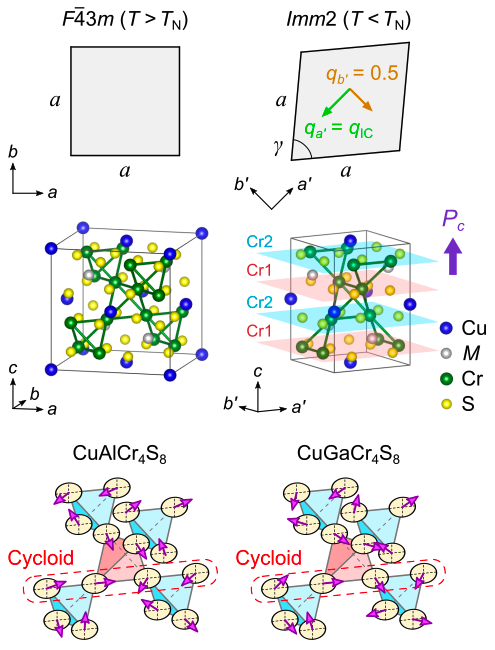Discovery of incommensurate helical magnetic order in breathing pyrochlore lattice magnets見
Breathing pyrochlore magnets, where the nearest-neighbor bonds within the small and large tetrahedra are characterized by exchange interactions of different strengths, provide a promising platform for exploring novel ground states. We successfully synthesized polycrystalline samples of the model compounds, A-site–ordered chromium spinels CuAlCr4S8 and CuGaCr4S8, and found that they exhibit rich magnetic-field-versus-temperature phase diagrams [A]. However, microscopic studies of the crystallographic and magnetic structures across the phase transitions have not yet been conducted.
CuAlCr4S8 and CuGaCr4S8 crystalize in a cubic structure with space group F-43m at room temperature. Upon cooling, they undergo magnetic transitions at TN = 21 K and 31 K, respectively, and exhibit antiferromagnetic behavior in the magnetic susceptibility with hysteresis. This suggests spin–lattice–coupling–driven magnetic transitions, as commonly observed in other chromium spinels, and therefore points to a magnetostructural transition. Our low-temperature powder X-ray diffraction reveals peak splitting below TN in both compounds, demonstrating that the low-temperature phase is orthorhombic with space group Imm2. Since this structure is polar along the c axis, a spontaneous electric polarization is expected. Furthermore, powder neutron diffraction shows the emergence of an incommensurate helical magnetic modulation characterized by the propagation vector Q = (qIC, 0.5, 0) [B]. The values of qIC are 0.39 for CuAlCr4S8 and 0.31 for CuGaCr4S8, indicating a relatively short modulation period and implying a significant role of bond frustration. Magnetic-structure analysis suggests a cycloidal-type order in which the spiral plane contains the propagation vector and the c axis as a candidate. Verifying the cross-correlated responses among spin, charge, and lattice using single crystals is an intriguing issue which shoule be addressed in the future.
[B] M. Gen et al., J. Phys. Soc. Jpn. 93, 104602 (2024). (Original paper[29])
CuAlCr4S8 and CuGaCr4S8 crystalize in a cubic structure with space group F-43m at room temperature. Upon cooling, they undergo magnetic transitions at TN = 21 K and 31 K, respectively, and exhibit antiferromagnetic behavior in the magnetic susceptibility with hysteresis. This suggests spin–lattice–coupling–driven magnetic transitions, as commonly observed in other chromium spinels, and therefore points to a magnetostructural transition. Our low-temperature powder X-ray diffraction reveals peak splitting below TN in both compounds, demonstrating that the low-temperature phase is orthorhombic with space group Imm2. Since this structure is polar along the c axis, a spontaneous electric polarization is expected. Furthermore, powder neutron diffraction shows the emergence of an incommensurate helical magnetic modulation characterized by the propagation vector Q = (qIC, 0.5, 0) [B]. The values of qIC are 0.39 for CuAlCr4S8 and 0.31 for CuGaCr4S8, indicating a relatively short modulation period and implying a significant role of bond frustration. Magnetic-structure analysis suggests a cycloidal-type order in which the spiral plane contains the propagation vector and the c axis as a candidate. Verifying the cross-correlated responses among spin, charge, and lattice using single crystals is an intriguing issue which shoule be addressed in the future.
References
[A] M. Gen et al., Phys. Rev. Mater. 7, 104404 (2023). (Original paper[24])[B] M. Gen et al., J. Phys. Soc. Jpn. 93, 104602 (2024). (Original paper[29])

